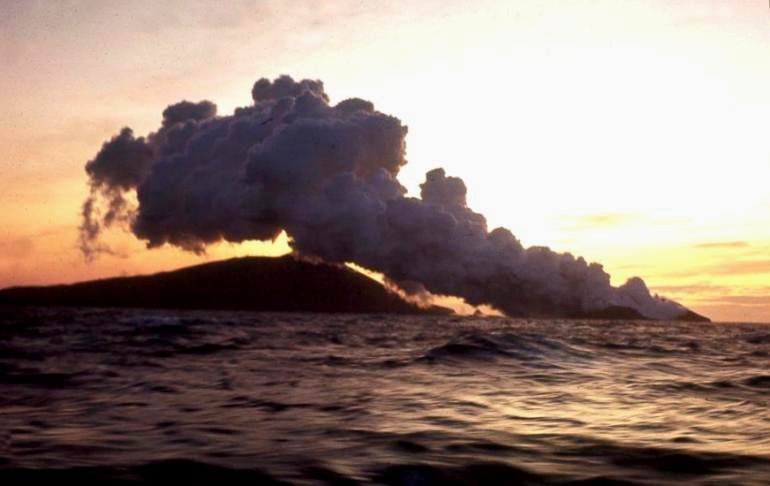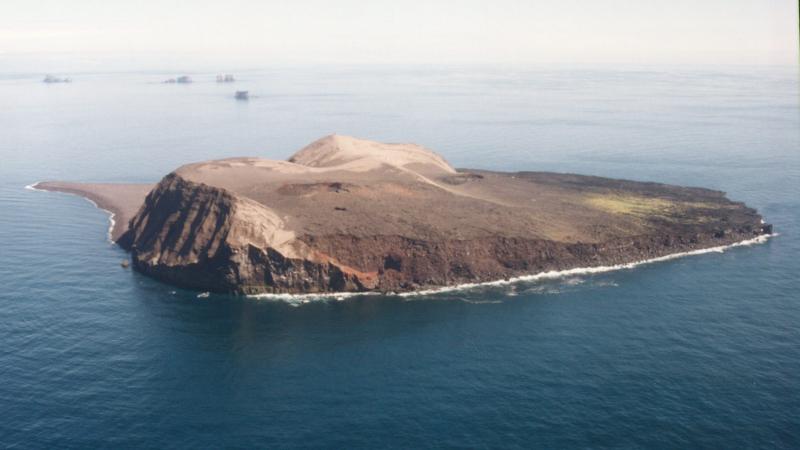Volcano Surtsey, Iceland (original) (raw)
More about Surtsey here:
 |
Plants |
|---|---|
 |
Birds |
 |
Bird migration |
 |
Fossils on Surtsey |
 |
Insects |
 |
Sealife |
new: wildlife/fauna during 40 years





 From the eruption 1963
From the eruption 1963
©voj c/o www.vulkaner.noOnboard the fishingvessel Ysleifur II was Olafur on watch, on November the 14 th, 1963,
at 07.15 in the morning. He suddenly felt some irregular movements aboard, as the vessel was caught in a whirlstream.
He looked around, and it seemed like something was raising from the ocean to the southeast. It was like a mountain,
but there should be no mountain in that direction. So he realised it had to be smoke, and waked up the captain as he was
afraid another ship was on fire.
The closest coast guard was alarmed, but noone had observed any calls for help. So, as the captain looked through his pair of binoculars, he could se some black ashfilled eruptionvolumes coming right up from the sea.
A submarine eruption had started off the Westmanna-islands. About 3 hours later, the eruption cloud was 3.500 m asl,
and the eruption covered a 400 m wide line. About 15.00 in the afternoon, the eruptioncloud reached the heigth of 6.000 m asl,
and now it could even be observed from the capital of Reykjavik several miles away. It was still a submarine eruption,
but the very night after, a new island was born: Surtsey.

© Thorleifur Einarsson
The first humans to put their feet on the island, were three french daredevils from a french
weekly magazine, managed to land on the island on December the 6th. They were able to stay
on the island for as long as 15 minutes, then another powerful eruption forced them to leave the island rather soon again.
It lasted several months before the eruption ended, and at that time Surtsey was an island
covering as much as 2.45 square kilometers. To build up this island the volcano had to fill up
with 700 millions cubic meters of lava and tephra. ...

In the summer of 1964 both flies and butterflies had arrived, and gulls had for a long time put
their feet on the cliffs, like many other migrating birds, happy to have found a resting place after their journey from
southern countries. The first vascular plants was to be found in june 1965,
and at the same time the first seals were observed on the beaches.
The above is a summary from the book 'SURTSEY, the new volcano island on Iceland'
by Sigurdur Thorarinsson. And below is a quotation I just have to include:

From the crater on Surtsey. Notice colour on the rocks,
and the moss which covers more and more as time goes.
The official Icelandic geologist, S. Thorarinsson writes,
'When (geologists) in the spring and summer of 1964 wandered about the island . . . they found it hard to believe that this was an island whose age was still measured in months,not years . . . What elsewhere may take thousands of years may be accomplished (in Iceland)in one century. . . (in) Surtsey. . . the same development may take a few weeks or evena few days.'
'On Surtsey only a few months sufficed for a landscape to be created which was so varied and mature that it was almost beyond belief . . . wide sandy beaches . . . precipitous crags . . .gravel banks and lagoons, impressive cliffs grayish white from the brine.. . hollows... glensand screes... boulders worn by the surf, some of which were almost round on an abrasionplatform cut into the cliffs.'
Some second thoughts when you read about how our country has been formed, through
millions of years. How the ocean has moved up blocks, which during thousands of years has
been washed and pulled around, and then they have become boulders on the beach...... and sandbeaches that once
were seashells and pebbles, and slowly have been smashed and
formed to small grains of sand during......(do I have to say more?)
A total of 24 different types of minerals have been
identified through research at Surtsey, which erupted
between 1963-67, with 12 never having been previously found
in Iceland and one never before discovered anywhere in the world.
Daily News from Iceland, August 8, 1996.
anyone having more info?
Double surprise for the geologists
In June 1967 stopped the eruption on Surtsey. The size of the island was 2,8 square kilometer on that time, the length was 2100 meter and the width was 1500. The height
was 169 meter. Two parts of three on the island consists of volcano ash, the other part
is lava. Water and heat that is still on the island has changed a part of the loose ash to a kind of hard glass looking rock called palagonit. This was a double surprise for many geologists.
At first because they till now thought that palagonit only was possible to be created
by volcanoes covered with ice, for example under the Icelandic glaciers’. Surtsey demonstrates that this process easily can take place without a cover of ice.
At second, it showed that the transformation occurred much faster than the geologist
had expected. Since this turned out Surtsey has become working as gigantic laboratory
and the textbooks in geology were rewritten because of the new knowledge.
Geologists have also got entirely new knowledge about erosions from the case Surtsey.
(C) Copyright Joel Hutters
anyone knowing his present address?

Surtsey Topography 1998
Measurements has shown that Surtsey has lost 0.024 km³ of its sfurface volume
since the end of the eruption late 1967.
From: http://dtam.gsfc.nasa.gov/research/garvin/surtsey.html
The shores
The tip of the island's northern spit is formed of a very unstable sandy beach, constantly
moving depending on the wind direction and force. In a few hours only the sand spit may
totally alter the form. This of course means that a firm fauna has difficulty in establishing
itself on this beach.
The extreme tip excluded, the shores of the northern spit are built up by boulders of varying
size. These boulders are frequently moved by heavy surf so most algal vegetation is
excluded from this beach, which thus looks quite sterile.

Boulders on a newborn island
© c/o www.vulkaner.no
The third shore type is found under the high cliffs on the east, south and west side of the
island. These shore are much more stable, compared with the northern spit, but are
nonetheless drastically alteered during winter storms. During the summer drastic changes
only take place when the surf is exceptionally heavy.
The inner part of the northern spit can be described as a sandy plain with boulders buried
to greater or lesser extent in the sand. Occasionally the sea flows over this plain, especially
in winter, forming a line of driftwood and variety of debris below the slopes.
The lava-field
In the lava the vegetation is making great progress. The moss cover is especially dominant
in the Durtur II crater and in the lava flow from Surtur I. However, it happens that tephra
covers the vegetation, and such destroyed. It also happens, as in the summer of 1978,
that drought destroys the fauna, and then it has to be build up again.
The north-eastern part of the lava-field has been partly covered by tephra. In that area
a simple plant community developed early, with the Honkenya peploides as the most
prominent plant.

Coastline changes from 1975 till 1998.
xx.xx.2001
When it was on its largest, the island covered 2,8 km² and was 172 m asl.
Today (in 2001) it has been reduced to some 1,4 km² and the highest point is at 154 m asl.
There are now 56 differend kinds of vascular plants, and 8 kinds of birds are nesting on the
island. Seeds come with wind and birds from the nearby islands, but migrating birds also bring seeds from places far away.
Surtsey is one of the favourite restinghabits for migrating birds to and from Iceland and Europe. They stop here by the thousands. Seals also favour this island, and are resting and breeding
on the beaches here.
July 23rd, 2002
Two new vascular plants has shown up on Surtsey. Scientists also found taht new insectshave moved to the island since the last research. The island is visited regularly each summer to
register changes in the environment.

Plantago maritima
Six biologist found the new plants when they arrived the island July the 15th, and made
research over a four day periode.De new plants found were Plantago maritima and Verucia. None of them had previously been observed on the island. The new insects included the Ceutorhynchus insularis. This has earlier only been registered two other places in the world, namely on the island of Dun, belonging to the St.Kilda archipelago in Great Britain, and on the much closer Vestmannaeyar.

A greylag goose has laid its eggs for the first time on Surtsey,
and in the summer of 2002 a pair were observed caring for three chickens.
(Iceland Review)
Surtsey is under heavy environmental restictions, so people are not allowed
to land on the island, unless for scientific research.
So far, www.vulkaner.no has no such scientific knowledge, but when we visited
Iceland in August, 2002, we met just the right people, and in the coming months
we do hope to be able to publish several interesting items on the life on Surtsey.
In the year 2002 the island will celebrate its 40th year in existence. .

Surtsey 1966
© c/o www.vulkaner.no
More about Surtsey here:
 |
Plants |
|---|---|
 |
Birds |
 |
Bird migration |
 |
Fossils on Surtsey |
 |
Insects |
 |
Sealife |

Foto: B. Edwards
| | Links: | |
| --------------------------------------------------------------------------------------------------------------------------------------------- | ------------------------------------------------------ |
| | Other volcanoes on Iceland: GRIMSVOTN HEKLA KATLA LAKI | |
|  | Explore North, Surtsey: Iceland's Island of Fire |
|
| Explore North, Surtsey: Iceland's Island of Fire |
|  | Marvelous pictures, but text icelandic |
| Marvelous pictures, but text icelandic |